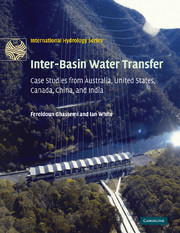Book contents
- Frontmatter
- Contents
- Foreword
- Overview and Scope
- Acknowledgements
- List of Abbreviations
- Part I The Challenges
- Part II Inter-basin Water Transfer in Australia
- 3 Land and water resources of Australia
- 4 The Snowy Mountains hydro-electric scheme
- 5 Inter-basin water transfer from coastal basins of New South Wales
- 6 The Bradfield and Reid schemes in Queensland
- 7 Three schemes for flooding Lake Eyre
- 8 The Goldfields pipeline scheme of Western Australia
- 9 Supplying Perth, Western Australia with water: the Kimberley pipeline scheme
- 10 Other schemes in Australia
- Part III Inter-basin Water Transfer in Other Selected Countries
- Part IV Appendices
- Glossary
- Index
- References
6 - The Bradfield and Reid schemes in Queensland
Published online by Cambridge University Press: 05 November 2009
- Frontmatter
- Contents
- Foreword
- Overview and Scope
- Acknowledgements
- List of Abbreviations
- Part I The Challenges
- Part II Inter-basin Water Transfer in Australia
- 3 Land and water resources of Australia
- 4 The Snowy Mountains hydro-electric scheme
- 5 Inter-basin water transfer from coastal basins of New South Wales
- 6 The Bradfield and Reid schemes in Queensland
- 7 Three schemes for flooding Lake Eyre
- 8 The Goldfields pipeline scheme of Western Australia
- 9 Supplying Perth, Western Australia with water: the Kimberley pipeline scheme
- 10 Other schemes in Australia
- Part III Inter-basin Water Transfer in Other Selected Countries
- Part IV Appendices
- Glossary
- Index
- References
Summary
THE BRADFIELD SCHEME
INTRODUCTION
In March 1938, J. J. C. Bradfield & Son Consulting Engineers from Sydney, submitted to the Queensland Government a report entitled “Queensland: The Conservation and Utilization of Her Water Resources”. The report described the rainfall pattern, the water resources of the State, and estimates of the damage caused by drought. It described also a proposal for the transfer of water from the coastal catchments of northern Queensland across the Great Dividing Range to inland rivers to increase the amount of water available for agriculture in central Queensland. The coastal rivers included in the proposal are located in a high annual rainfall area of Queensland. Their average annual flows at their mouths are listed in Table 6.1. Bradfield proposed to divert water from the Tully River to the Herbert River, and then across to the Burdekin River. Water stored on the Upper Burdekin River would flow by gravity south-westerly to the upper reaches of the Flinders River, and then to the Thomson River, where it would flow to Cooper Creek (Figure 6.1).
The elevation measurements required for the development of the Scheme were taken with a barometer (Raxworthy, 1989, pp. 135–137). This led to inaccuracies in land elevations and some mistakes in the development of the proposal. The following sections describe some details of the Bradfield Scheme, based on the Bradfield (1938) report.
- Type
- Chapter
- Information
- Inter-Basin Water TransferCase Studies from Australia, United States, Canada, China and India, pp. 125 - 138Publisher: Cambridge University PressPrint publication year: 2007



